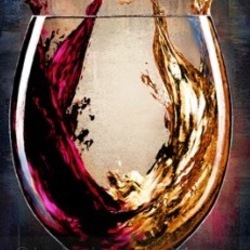Union Of Winemaking Cooperatives Of Samos
Sous le Végétal
Livia Samos Muscat 2019
Really interesting. This is totally dry and not fruity, but with a rounded herbaceousness, as well as a sense of the minerality and salinity of its volcanic island terroir. It’s also evident that this is as natural and unmodulated style of lively winemaking as you can imagine. — 3 years ago
Meristem Wines
McMinnville Ava Pinot Noir 2013
The twins. Vince & Cheney Vidrine. These wines are gone, Vince took an assistant winemaker position with Domaine Serene and they made him ditch the brand. Cheney was an assistant winemaker with Union Wine Company.Dont think either is with those companies any longer, last I heard they are in Southern Oregon. Have no idea if it’s true. Damn shame, this was one of the most exciting projects in the valley before it went sideways.
Crazy interesting to see how this has evolved. This is insanely reductive winemaking that opens in front of your eyes to dark red fruit with structure and balance. Popped the bottle and it was stinky as can be! Great stuff, glad I didn’t give up on this out of the gate and saw the opportunity that was coming. Wine is in a really interesting spot. Wish I had another bottle to see where this goes down the road — 7 years ago
Winzer Krems
Chremisa Grüner Veltliner 2023
Winzer Krems – Grüner Veltliner – Chremisa Edition
Lower Austria (Niederösterreich), Austria 🇦🇹
Overview
Created in 1995 to honor the 1,000-year anniversary of the City of Krems (first recorded in 995 AD), the Chremisa Edition has become a flagship expression of Austrian Grüner Veltliner. It shows why this grape, deeply rooted in Lower Austria, is revered worldwide: structured, spicy, mineral-driven, and endlessly food-friendly.
Aromas & Flavors
Bright aromas of grapefruit, honeysuckle, and orchard blossoms, lifted by Grüner’s signature white pepper note. On the palate, it’s refreshing yet layered, with citrus zest, green apple, and a mineral streak that gives precision and elegance.
Mouthfeel
Medium-bodied, lively, and perfectly balanced. Acidity cleanses and recalibrates the palate, while a subtle spiciness adds dimension. Crisp yet textured, finishing long with finesse.
Winemaking Notes
Produced under the Sandgrube 13 label of Winzer Krems, one of Austria’s most historic cooperatives. Grapes are sourced from vineyards along the Danube with loess and primary rock soils, ideal for showcasing Grüner’s minerality. Stainless-steel vinification preserves freshness and typicity.
Food Pairing
An all-rounder: pairs beautifully with schnitzel, roast chicken, or veal; also great with baked mushrooms, Asian cuisine, or tangy vinaigrette salads. Can be enjoyed as an aperitif or even as a “meditation wine” on its own.
Verdict
A timeless Grüner — layered, spicy, refreshing — bridging Austria’s thousand-year wine heritage with today’s palate.
📚 Educational Sidebar – Austria’s Grüner Legacy
Grüner Veltliner is Austria’s signature white grape, covering nearly one-third of all vineyards. Famous for its peppery spice, bright acidity, and food-pairing versatility, it thrives in regions like Kremstal, Kamptal, and Wachau. Look for styles ranging from light “Steinfeder” to powerful, age-worthy “Smaragd” in Wachau classifications. — 5 months ago
Union of Winemaking Cooperatives of Samos
Anthemis Vin de Liqueur Muscat 2012
Fantastic!!! — 6 years ago
Union of Winemaking Cooperatives of Samos
Psilés Korfés Muscat 2016
Dry, aromatik, bukeli — 7 years ago
Union Sacré
Noble Central Coast Pinot Gris Blend 2023
Union Sacré “Noble” 2022
Paso Robles, Central Coast, California, USA 🇺🇸
Overview
A vigorous and wildly expressive skin-contact white blend crafted in Paso Robles’ Tin City. Composition: 34% Pinot Gris, 34% Pinot Blanc, 32% Riesling. Union Sacré is known for its Franco-Californian artisanal edge, and Noble embodies that spirit—a hazy, unfiltered, dry wine that leans into the modern “orange wine” style while keeping it approachable and refreshing.
Aromas & Flavors
Bursts with peach, tangerine peel, grapefruit zest, and white flowers. The Riesling brings tension and aromatic lift, Pinot Gris provides stone fruit depth, while Pinot Blanc adds texture and backbone.
Mouthfeel
Fresh, bright, and layered with a lingering but pleasant finish. The skin contact gives a subtle tannic grip, while fermentation in concrete vats enhances minerality and freshness.
Winemaking Notes
Hand-sorted grapes undergo 14 days of skin maceration in concrete vats, then the wine is aged 5 months before bottling. Unfined, unfiltered, naturally hazy—a hallmark of its artisanal character.
Food Pairing
Pairs effortlessly with grilled shrimp, saffron rice, Mediterranean mezze, or summer salads. Also a perfect “patio pounder” when served chilled.
Verdict
Union Sacré Noble is a playful yet serious orange-styled wine, combining freshness with rustic authenticity. A conversation starter and a crowd-pleaser—exactly what Tin City Paso Robles is all about. Cheers! 🍊✨
— 8 months ago
Union of Winemaking Cooperatives of Samos
Samos Nectar White Muscat
Deep sweet taste, great smell .
— 5 years ago
Union of Winemaking Cooperatives of Samos
Muscat Samos Vin Doux vin de liqueur
A quality sweet wine. Ideally paired with desserts and fruit. — 7 years ago
Château Branaire (Duluc-Ducru)
St. Julien Red Bordeaux Blend 2006
On the nose, bright, ripe, ruby; blackberries, dark cherries, black raspberries, blue fruit mix, strawberries, creamy raspberries, plums, cranberries, black tea, loamy soils, dry clay, dry stones, limestone minerals, saddlewood, crush dry rocks, dark moist soils, dark chocolate, vanilla, field of violets, lavender and fresh red florals.
The palate is medium-full yet a little lean. The fruits are elegant, ruby, ripe; blackberries, dark cherries, black raspberries, blue fruit mix, strawberries, creamy raspberries, plums, cranberries, black tea, loamy soils, dry clay, dry stones, limestone minerals, used leather, cedar, crush dry rocks, dark moist soils, dark chocolate, vanilla, field of violets, lavender and fresh red florals. The acidity is very good. The length, balance and length are nice. The structure a little lean. It a well polished rich fruit finish, but is a little short.
Photos of; the Chateau, Owner Patrick Maroteaux (may he RIP), Estate grapes and their barrel room.
Producer notes & history...Branaire Ducru has a long history has a long history that dates back to 1680. In those days, Branaire Ducru was a part of a larger Beychevelle. When the owner of Beychevelle passed away, he left behind a huge Bordeaux vineyard that was seriously in debt. To pay off the debt, the vineyard was broken up and sold. Several new estates were created in Saint Julien, which include Chateau Branaire Ducru. Jean-Baptiste Braneyre created the estate in 1680. As was was tradition in Bordeaux, the owner gave the estate his name, which is where the first part of the properties name came was given. Braneyre was later altered to Branaire. Braneyre bought the land we know as Branaire Ducru because of the terroir. He understood that Cabernet Sauvignon grew best on the deep gravel soils found in the Medoc. With that, we have the birth of Branaire Ducru. Or, at least the Branaire part. The middle name was gained through marriage. Marie Braneyre married Pierre de Luc which as you can guess, gave us the Branaire Duluc (the name of their 2nd wine). Almost 100 years later, the first winery at the property was constructed in 1824. It took almost 200 years for the Ducru portion of the wines name to make its way to the label. In 1875, with no direct descendants, Gustave Ducru, a more distant relative took over the property and added his name to the label making it, Chateau Branaire Ducru.
Patrick Maroteaux bought Branaire Ducru in 1988 from the Tapie family who had owned It since 1919. Prior to his ownership of Branaire Ducru, Patrick Maroteaux had no prior experience in the wine business. His background was in banking and then a president of the massive sugar company, Eurosucre. Patrick Maroteaux also served as the President of the UGCB, Union of Grand Crus Bordeaux, and as the President of the Saint Julien appellation.
Since his purchase, Patrick Maroteaux has focused much of his efforts on performing extensive work in the vineyards and in the cellars. He also began reducing the yields. Additionally, he increased the size of their vineyards by 10 hectares. Patrick was also modernized their winemaking techniques.
In fact, Patrick Maroteaux was one of the first producers in the Left Bank to being filling his tanks entirely by gravity. He did this beginning with the 91 vintage. This was done with the help of Philippe Dhalluin.
Philippe Dhalluin left Branaire Ducru in 2004 and took the same position as the director for wine making at Chateau Mouton Rothschild. Philippe Dhalluin was replaced by Jean Dominique Videau.
Chateau Branaire Ducru is a family business. The son of Patrick Maroteaux, François Xavier Maroteaux has carried the family business and joined the estate. Sadly, on November 19, 2017, Patrick Maroteaux passed away at the age of 67. His son, François Xavier Maroteaux took over the full time responsibilities of managing the property.
All the new technical improvements at Branaire Ducru quickly paid off for Patrick Maroteaux. Beginning with the 2000 vintage, Branaire Ducru became one of the top Saint Julien wines. It’s also one of the better values for high quality Bordeaux.
The 60 hectare vineyard of Branaire Ducru is planted to 65% Cabernet-Sauvignon, 28% Merlot, 4% Cabernet Franc and 3% Petit Verdot. The vineyard is very close to the size it was during the time of the 1855 Classification.
The terroir is deep gravel with clay soils. The best terroir is located near the chateau, closest to the Gironde river. They also have blocks further inland, with a small section of vines placed close to Chateau Lagrange and Chateau Talbot. The vineyard can be divided into 15 different blocks with 70 different parcels of vines. On average, the vines are close to 35 years of age. However, the estate has older vines as well. The oldest vines date back close to 90 years of age. The vineyard is planted to a vine density that ranges from 6,700 to 10,000 vines per hectare. The higher levels of vine density are for the newer plantings. The goal of the property is to continue increasing the vine density in all of their better terroirs.
Branaire Ducru, fermentation takes place in 28 temperature controlled, stainless steel tanks. The 28 vats vary in size. The vats range in size from as small as 30 hectoliters and up to 210 hectoliters. Each vat is sized for the needs of each specific vineyard parcel. Each vat is filled using the gravity based system.
Branaire Ducru is aged in 60 to 65% new, French oak barrels for between 16-20 months. The amount of new oak varies depending on the quality, character and style of each vintage. On average, the annual production is about 25,000 cases depending on the vintage. — 8 years ago










Freddy R. Troya
Conuvio Pinot Grigio 2024
Valdadige DOC, Veneto–Trentino Alto Adige, Italy 🇮🇹
Overview
Made from 100% Pinot Grigio, this wine hails from the Valdadige DOC (Adige Valley), a cooler Alpine-influenced corridor straddling Trentino-Alto Adige and Veneto. Recognized as a benchmark area for Pinot Grigio, Valdadige delivers freshness, minerality, and elegance far beyond mass-market examples. The name Conuvio means “coming together” or “union,” symbolizing the blending of these mountain terroirs into one distinctive wine.
Aromas & Flavors
Bright and zesty with pear, green apple, citrus zest, and white flowers, layered over a subtle wet-stone minerality. A touch of almond skin lingers on the finish, giving complexity to its clean fruit core.
Mouthfeel
Light-bodied, crisp, and lively, with brisk acidity and a refreshing finish. Vibrant and uncomplicated, yet elegant enough to stand out.
Winemaking Notes
Fermented in stainless steel to preserve freshness and purity, bottled young to lock in vibrancy.
Food Pairing
Pairs naturally with grilled seafood, caprese salad, shrimp scampi, and light antipasti. Also a perfect aperitif.
Verdict
A classic Valdadige Pinot Grigio—fresh, mineral, and versatile. What makes it special is its balance of Alpine freshness and food-friendly character, elevating it above everyday Pinot Grigio. A daily sipper with a story and soul. 🍋 cheers! — 3 months ago